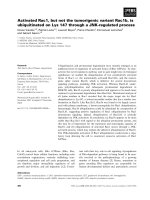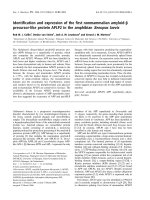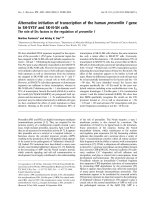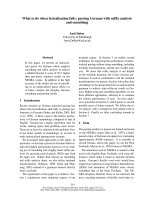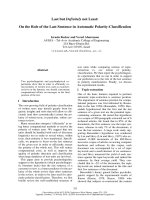Báo cáo khoa hoc:" Host factors do not influence the colonization or infection by fluconazole resistant Candida species in hospitalized patients" ppsx
Bạn đang xem bản rút gọn của tài liệu. Xem và tải ngay bản đầy đủ của tài liệu tại đây (461.94 KB, 5 trang )
BioMed Central
Page 1 of 5
(page number not for citation purposes)
Journal of Negative Results in
BioMedicine
Open Access
Research
Host factors do not influence the colonization or infection by
fluconazole resistant Candida species in hospitalized patients
Yun-Liang Yang
1
, Ming-Fang Cheng
2,3
, Ya-Wen Chang
4
, Tzuu-Guang Young
5
,
Hsin Chi
6
, Sai Cheong Lee
7
, Bruno Man-Hon Cheung
8
, Fan-Chen Tseng
4
,
Tun-Chieh Chen
9
, Yu-Huai Ho
10
, Zhi-Yuan Shi
11
, Chung-
Huang Hubert Chan
12
, Ju-Yu Lin
4
and Hsiu-Jung Lo*
4
Address:
1
Department of Biological Science and Technology, National Chiao Tung University, Hsinchu, Taiwan, Republic of China,
2
Department
of Pediatrics, Veterans General Hospital-Kaohsiung, Kaohsiung, Taiwan, Republic of China,
3
National Yang-Ming University, Taipei, Taiwan,
Republic of China,
4
Division of Clinical Research, National Health Research Institutes, Miaoli, Taiwan, Republic of China,
5
Section of Infection
Diseases, Taipei Municipal Zen Ai Hospital, Taipei, Taiwan, Republic of China,
6
Section of Infection Diseases, Mackay Memorial Hospital Taitung
Branch, Taitung, Taiwan, Republic of China,
7
Division of Infectious Diseases, Chang Gung Memorial Hospital, Keelung, Taiwan, Republic of
China,
8
Section of Infection Diseases, Tainan Municipal Hospital, Tainan, Taiwan, Republic of China,
9
Section of Infection Diseases, Kaohsiung
Medical College Chung-Ho Memorial Hospital, Kaohsiung, Taiwan, Republic of China,
10
Section of Infection Diseases, Buddhist, Tzu-Chi General
Hospital, Hualien, Taiwan, Republic of China,
11
Section of Infection Diseases, Veterans General Hospital-Taichung, Taipei, Taiwan, Republic of
China and
12
Department of Hematology and Oncology, Chang-Gung Memorial Hospital-Chiayi, Chiayi, Taiwan, Republic of China
Email: Yun-Liang Yang - ; Ming-Fang Cheng - ; Ya-Wen Chang - ;
Tzuu-Guang Young - ; Hsin Chi - ; Sai Cheong Lee - ; Bruno Man-
Hon Cheung - ; Fan-Chen Tseng - ; Tun-Chieh Chen - ; Yu-
Huai Ho - ; Zhi-Yuan Shi - ; Chung-Huang Hubert Chan - ; Ju-
Yu Lin - ; Hsiu-Jung Lo* -
* Corresponding author
Abstract
Nosocomial yeast infections have significantly increased during the past two decades in
industrialized countries, including Taiwan. This has been associated with the emergence of
resistance to fluconazole and other antifungal drugs. The medical records of 88 patients, colonized
or infected with Candida species, from nine of the 22 hospitals that provided clinical isolates to the
Taiwan Surveillance of Antimicrobial Resistance of Yeasts (TSARY) program in 1999 were
reviewed. A total of 35 patients contributed fluconazole resistant strains [minimum inhibitory
concentrations (MICs) ^ 64 mg/l], while the remaining 53 patients contributed susceptible ones
(MICs % 8 mg/l). Fluconazole resistance was more frequent among isolates of Candida tropicalis
(46.5%) than either C. albicans (36.8%) or C. glabrata (30.8%). There was no significant difference in
demographic characteristics or underlying diseases among patients contributing strains different in
drug susceptibility.
Background
Nosocomial infections caused by yeasts have increased
significantly in the past two decades in Taiwan as well as
other industrialized countries [1-4]. Infections by Candida
species are important causes of morbidity and mortality in
immunocompromised patients. The increase in the prev-
Published: 16 December 2008
Journal of Negative Results in BioMedicine 2008, 7:12 doi:10.1186/1477-5751-7-12
Received: 19 September 2008
Accepted: 16 December 2008
This article is available from: />© 2008 Yang et al; licensee BioMed Central Ltd.
This is an Open Access article distributed under the terms of the Creative Commons Attribution License ( />),
which permits unrestricted use, distribution, and reproduction in any medium, provided the original work is properly cited.
Journal of Negative Results in BioMedicine 2008, 7:12 />Page 2 of 5
(page number not for citation purposes)
alence of fungal infections is closely associated with inva-
sive medical procedures and the intense use of antibiotics
in high-risk patients [5,6]. Resistance to antifungals has
emerged in association with the increased use of these
drugs [7-9].
The Taiwan Surveillance of Antimicrobial Resistance of
Yeasts (TSARY) program was first implemented by the
National Health Research Institutes (NHRI) in 1999 to
prospectively assess the magnitude of the problem of
yeast infection and drug resistance. Clinical isolates of
yeasts were obtained from 22 geographically representa-
tive hospitals in Taiwan. Emergence of fluconazole resist-
ant Candida species was documented in 1999 shortly after
the surveillance program was instituted [9-11]. The survey
revealed that 8.4% of the collected 632 clinical isolates
were resistant [minimum inhibitory concentration (MIC)
^ 64 mg/l] to fluconazole [12]. Furthermore, there is an
association between the rate of fluconazole resistance and
the number of non-albicans Candida species collected
from different regions and hospital types [13,14]. This
study was a follow-up, designed to determine whether
intrinsic host factors of patients might influence the fre-
quency of colonization or infection by fluconazole resist-
ant strains.
Methods
Subjects
Yeast isolates were collected as described [15] from the 22
hospitals participating in TSARY in 1999. In principle,
only one isolate was accepted from each patient. The
number of clinical isolates with MICs ^ 64 mg/l contrib-
uted from each hospital participating in TSARY program
in 1999 ranging from none to ten [13,16]. Therefore, we
chose hospitals contributed at least three clinical isolates
with MICs ^ 64 mg/l for this study. In total, there were 40
isolates with MICs ^ 64 mg/l from nine chosen hospitals.
However, medical information of five patients was not
available. Thus, we have reviewed all 35 available ones.
Patients with resistant strains were matched at a ratio of
about 1:2 with those with susceptible strains according to
the body sites from which the yeasts were isolated in the
same hospital. Each hospital contributed from 7 to 21
patients into the study. Clinical data were recorded on
standardized forms and analyzed according to demo-
graphic characteristics, hospital unit, duration of stay, pre-
disposing factors, antimicrobial therapy, underlying
illnesses, and laboratory findings. The definition of diabe-
tes, hypertension, pulmonary diseases, bacterial infection,
antifungal, antibiotics, antituberculous agents, dialysis,
catheter insertion, and mobility affected were recorded
when the Candida species were isolated. The outcome
(mortality) was documented within three months after
those stains were isolated. The protocol was approved by
Institutional Review Board (IRB) of the National Health
Research Institutes.
Susceptibility tests
The MICs to fluconazole were determined according to
the guidelines of the Clinical and Laboratory Standards
Institute (CLSI) for in vitro antifungal susceptibility testing
[12]. The RPMI medium 1640 (31800-022) provided by
Gibco BRL was used for the testing. Strains from American
Type Culture Collection including Candida albicans
(ATCC 90028), Candida krusei (ATCC 6258), and Candida
parapsilosis (ATCC 22019) were used as the standard con-
trols. The final growth of each isolate was measured by
Biotrak II plate reader (Amershan Biosciences, Biochrom
Ltd., Cambridge England) after incubated at 35°C for 48
hours. The MICs of fluconazole were defined as the mini-
mum inhibitory concentrations of drugs capable of reduc-
ing the turbidity of cells to greater than 50%. Isolates with
MIC ^ 64 mg/l were considered to be resistant, whereas
those with MIC % 8 mg/l were susceptible. Isolates with
MICs falling in between (16 – 32 mg/l) were susceptible-
dose dependent.
Statistical analysis
The chi-square test or Fisher's exact test were used for cat-
egorical variables. The Student T-test was used for contin-
uous variables. Logistic regression was used to assess the
independent effect of factors that were significant in the
univariate analysis or were important to the association of
interest. A probability (P) < 0.05 was considered signifi-
cant.
Results
A total of 35 patients from nine hospitals were selected
and each one of them has contributed one clinical fluco-
nazole resistant isolate. As a comparison, we have also
reviewed 53 patients contributing susceptible isolates
(with MICs % 8 mg/l) from the same nine hospitals. Of
the 88 isolates, there were three Candida species and their
distribution in relation to the susceptibility to fluconazole
is shown in Table 1. It shows that fluconazole resistance
was found to be more frequent in C. tropicalis than either
C. albicans or C. glabrata. The distribution of body sites
from which the yeasts were isolated is shown in Table 2.
Most isolates were from urine (52.3%) and sputum
(23.9%) and candidemia was diagnosed in six patients
(6.8%). Both C. glabrata and C. tropicalis were isolated
more frequently from the urine than C. albicans (61.5%
vs. 60.5% vs. 21.0%, respectively), whereas C. albicans was
dominant in sputum than C. glabrata or C. tropicalis
(47.4% vs. 15.4% vs. 18.6%, respectively).
The analysis of fluconazole susceptibility according to
characteristics of different patients is shown in Table 3.
There was no significant difference correlated to host fac-
Journal of Negative Results in BioMedicine 2008, 7:12 />Page 3 of 5
(page number not for citation purposes)
tors such as different demographic characteristics and
underlying diseases other than the possibility of pulmo-
nary tuberculosis. The observation that patients with pul-
monary diseases, particularly those receiving
antituberculous agents were found to be more frequently
colonized or infected with fluconazole resistant yeasts
requires further investigation. Although patients' ages did
not significantly differ between two groups, we still adjust
its effect in the multivariate analysis because age might
influence hosts' underlying conditions the acquisition of
infections. In a logistic regression, which included the
presence of pulmonary diseases (yes/no), use of antitu-
berculous agents (yes/no) and age (continuous in years),
the former two showed some associations but age did not
(p = 0.23, details no shown). Use of antituberculous
agents was associated with an odds ratio (OR) = 4.2, p =
0.05 for the resistance to the fluconazole, while the pres-
ence of pulmonary diseases was with OR = 2.7, p = 0.1.
Discussion
It is well established that mechanically supported or
immunocompromised patients with invasive devices are
at increasing risk of colonization and infection with path-
ogenic yeasts [5,17]. The findings of this study further sug-
gest that there is no difference in frequency between
fluconazole resistant and susceptible Candida species to
colonize or infect individual patients according to the
host factors analyzed. Hence, fluconazole resistant strains
do not appear to have more advantage than susceptible
ones in these patients. Many nosocomial Candida infec-
tions are endogenously acquired [18-21]. It is much more
likely that the increase of fluconazole resistant yeasts has
resulted from the intense use of fluconazole in response to
increasing prevalence of nosocomial yeast infections.
In the previous study, the resistant rate was found to asso-
ciate with regions and hospital types [13]. In this study,
we set out to investigate whether the hosts per se was an
influencing factor, since regional difference may be a
reflection of host characters. As it turned out, patients
receiving antituberculous agents had higher occurrence to
be colonized or infected with fluconazole resistant strains.
These 10 ten patients receiving antituberculous agents
were not associated with either regions or types of hospi-
tal.
Among HIV-infected patients, treatment with antitubercu-
lous drugs, previous history of tuberculosis, and flucona-
zole exposure are the risks for development of
oropharyngeal colonization or infections by fluconazole-
resistant Candida strains [22]. Noteworthily, findings
from this study indicate that non-HIV infected patients
receiving antituberculous agents had higher occurrence to
be colonized or infected with fluconazole resistant strains.
Interestingly, a link between mycobacterial infections and
oropharyngeal candidiasis in HIV-infected patients has
been reported. The prevalence of Candida species coloni-
zation or infections in AIDS patients in the tuberculous
Table 1: Distribution of fluconazole susceptibilities among Candida species isolated from patients in the nine hospitals
C. albicans C. glabrata C. tropicalis Total
MIC (mg/l) Number % Number % Number % Number %
^ 64 7 36.8 8 30.82046.53539.8
% 8 1263.21869.22353.55360.2
Total 19 100 26 100 43 100 88 100
MIC, minimum inhibitory concentration.
Table 2: Distribution of body sites of Candida species with different fluconazole susceptibility
MICs ^ 64 mg/l MICs % 8 mg/l Total
Source C. albicans C. glabrata C. tropicalis Subtotal C. albicans C. glabrata C. tropicalis Subtotal number %
Urine 0 5 11 16 4 11 15 30 46 52.3
Sputum 4 1 5 10 5 3 3 11 21 23.9
Blood 00 3303 0366.8
Wound2002102355.7
Fluid 0101101233.4
Genital tract 1 1 1 3 1 1 1 3 6 6.8
Catheter tip 0 0 0 0 0 0 1 1 1 1.1
Total 7 8 20 35 12 18 23 53 88 100
MIC, minimum inhibitory concentration; Fluid consisted of ascites, dialysate, and peritoneal fluid.
Journal of Negative Results in BioMedicine 2008, 7:12 />Page 4 of 5
(page number not for citation purposes)
group was 2.5-fold higher than that without tuberculosis
[23]. One possible explanation for this phenomenon is
that antituberculous agents may change the microbial
ecosystem in the body to favor Candida species [22]. Anti-
biotics, such as quinolones, reduces the effects of antifun-
gal agents in a murine model of invasive candidiasis [24].
Hence, antituberculous agents may also antagonize the
effects of antifungal agents to prolong survival of Candida
species and consequently the development of drug resist-
ance. The mechanism by which the usage of antitubercu-
lous agents is a risk for colonizing or infecting with
fluconazole resistant strains is worthy of further study by
a larger series.
Abbreviations
TSARY: Taiwan Surveillance of Antimicrobial Resistance
of Yeasts; MIC: minimum inhibitory concentration;
NHRI: National Health Research Institutes; CLSI: Clinical
and Laboratory Standards Institute; IRB: Institutional
Review Board.
Competing interests
The authors declare that they have no competing interests.
Authors' contributions
YLY conceived the study and designed it together with
MFC and HJL. MFC, YWC, TGY, HC, SCL, BMHC, TCC,
YHH, ZYS, CHHC, and JYL reviewed medical charts of
patients. FCT performed the statistical study. YLY drafted
the manuscript with contribution from HJL.
Acknowledgements
We would like to thank C. M. Kunin for his critical review of the manuscript
and Pfizer for supplying the fluconazole. We also thank the nine participat-
ing hospitals for providing clinical isolates and information regarding to
these isolates. They are Chang Gung Memorial Hospital at Keelung, Taipei
Municipal Zen Ai Hospital, Tri Service General Hospital, Veterans General
Hospital-Taichung, Tainan Municipal Hospital, Veterans General Hospital-
Kaohsiung, Buddhist Tzu-Chi General Hospital, Mackay Memorial Hospital
Taitung Branch, and Kaohsiung Medical College Chung-Ho Memorial Hos-
pital. This study was supported by the grant NHRI CL-096-PP07.
References
1. Chen YC, Chang SC, Sun CC, Yang LS, Hsieh WC, Luh KT: Secular
trends in the epidemiology of nosocomial fungal infections at
a teaching hospital in Taiwan, 1981 to 1993. Infect Control Hosp
Epidemiol 1997, 18(5):369-375.
2. Cheng MF, Yu KW, Tang RB, Fan YH, Yang YL, Hsieh KS, Ho M, Lo
HJ: Distribution and antifungal susceptibility of Candida spe-
cies causing candidemia from 1996 to 1999. Diagnostic Microbi-
ology and Infectious Disease 2004, 48(1):33-37.
3. Hung CC, Yang YL, Lauderdale TL, McDonald LC, Hsiao CF, Cheng
HH, Ho YA, Lo HJ: Colonization of human immunodeficiency
Table 3: Characteristics of patients colonized or infected with Candida species
Fluconazole susceptibility
Characteristics Total MICs ^ 64 mg/l MICs % 8 mg/l
Mean of age (years) 65.5 65.0 66.3
Duration of hospital stay (days) 58.0 (N = 78) 60.0 (N = 30) 56.7 (N = 48)
Duration of fever (days) 10.2 (N = 62) 10.7 (N = 24) 9.8 (N = 38)
number % number % number % p value
Hospitalization 80 91 32 91 48 90.6 0.81
Medical units 59 75 23 71.2 36 75 0.99
Surgery units 21 25 9 28.8 12 25 0.94
Intensive care units 39 43.3 17 48.6 22 41.5 0.51
Fever (^ 38°C) 58 72.5 22 62.9 36 67.9 0.79
Age > 65 57 64.8 22 62.9 35 66 0.76
Male 43 48.9 19 54.3 24 45.3 0.41
Mobility affected 60 68.2 23 65.7 37 69.8 0.69
Underlying diseases
Diabetes 38 43.2 14 40 24 45.3 0.62
Pulmonary diseases 15 17.1 9 25.7 6 11.3 0.08
Hypertension 10 11.4 4 11.4 6 11.3 1
Bacterial infection 57 64.8 22 62.9 35 66.0 0.76
Special medications or managements
Antifungal agents 18 20.5 7 20.0 11 20.8 0.93
Antibiotics 76 86.4 29 82.9 47 88.7 0.53
Antituberculosis agents 10 11.4 7 20 3 5.7 0.05
Dialysis 4 4.6 1 2.9 3 5.7 0.65
Catheter insertion 70 79.6 28 80.0 42 69.3 0.85
Mortality 38 43.2 16 45.7 22 41.5 0.87
Total 88 100 35 100 53 100
Publish with BioMed Central and every
scientist can read your work free of charge
"BioMed Central will be the most significant development for
disseminating the results of biomedical research in our lifetime."
Sir Paul Nurse, Cancer Research UK
Your research papers will be:
available free of charge to the entire biomedical community
peer reviewed and published immediately upon acceptance
cited in PubMed and archived on PubMed Central
yours — you keep the copyright
Submit your manuscript here:
/>BioMedcentral
Journal of Negative Results in BioMedicine 2008, 7:12 />Page 5 of 5
(page number not for citation purposes)
virus-infected outpatients in Taiwan with Candida species.
Journal of Clinical Microbiology 2005, 43(4):1600-1603.
4. Wisplinghoff H, Bischoff T, Tallent SM, Seifert H, Wenzel RP, Edmond
MB: Nosocomial bloodstream infections in US hospitals:
analysis of 24,179 cases from a prospective nationwide sur-
veillance study. Clin Infect Dis 2004, 39(3):309-317.
5. White TC, Marr KA, Bowden RA: Clinical, cellular, and molecu-
lar factors that contribute to antifungal drug resistance. Clin-
ical Microbiology Reviews 1998, 11(2):382-402.
6. Yang YL, Lo HJ: Mechanisms of antifungal agent resistance. J
Microbiol Immunol Infect 2001, 34(2):79-86.
7. Marr KA, Lyons CN, Ha K, Rustad TR, White TC: Inducible azole
resistance associated with a heterogeneous phenotype in
Candida albicans. Antimicrobial Agents and Chemotherapy 2001,
45(1):52-59.
8. Pfaller MA, Diekema DJ, Messer SA, Boyken L, Hollis RJ: Activities
of fluconazole and voriconazole against 1,586 recent clinical
isolates of Candida species determined by Broth microdilu-
tion, disk diffusion, and Etest methods: report from the
ARTEMIS Global Antifungal Susceptibility Program, 2001.
Journal of Clinical Microbiology 2003, 41(4):1440-1446.
9. Yang YL, Wang AH, Wang CW, Cheng WT, Li SY, Lo HJ, Hospitals
T: Susceptibilities to amphotericin B and fluconazole of Can-
dida species in TSARY 2006. Diagnostic Microbiology and Infectious
Disease 2008, 61(2):175-180.
10. Yang YL, Ho YA, Cheng HH, Lo HJ: Distribution and susceptibil-
ity to amphotericin B and fluconazole of Candida spp. iso-
lated from Taiwan. Epidemiology and Infection 2005,
133(2):325-330.
11. Yang YL, Cheng HH, Lo HJ: In vitro activity of voriconazole
against Candida species isolated in Taiwan. International Journal
of Antimicrobial Agents 2004, 24(3):294-296.
12. Clinical, Laboratory Standards I: Reference method for broth
dilution antifungal susceptibility testing of yeasts; approved
standard. M27A, Wayne, PA 1997.
13. Yang YL, Cheng HH, Ho YA, Hsiao CF, Lo HJ: Fluconazole resist-
ance rate of Candida species from different regions and hos-
pital types in Taiwan. J Microbiol Immunol Infect 2003,
36(3):187-191.
14. Yang YL, Cheng HH, Lo HJ: Distribution and antifungal suscep-
tibility of Candida species isolated from different age popu-
lations in Taiwan. Med Mycol 2006, 44(3):237-242.
15. Lo HJ, Ho AH, Ho M: Factors accounting for mis-identification
of Candida species. Journal of Microbiology, Immunology, and Infection
2001, 34:171-177.
16. Yang YL, Ho YA, Cheng HH, Ho M, Lo HJ: Susceptibilities of Can-
dida species to amphotericin B and fluconazole: the emer-
gence of fluconazole resistance in Candida tropicalis. Infection
Control and Hospital Epidemiology 2004, 25(1):60-64.
17. Yang YL: Virulence factors of Candida species. J Microbiol Immu-
nol Infect 2003, 36(4):223-228.
18. Chou HH, Lo HJ, Chen KW, Liao MH, Li SY: Multilocus sequence
typing of Candida tropicalis shows clonal cluster enriched in
isolates with resistance or trailing growth of fluconazole.
Diagnostic Microbiology and Infectious Disease 2007, 58(4):427-433.
19. Li SY, Yang YL, Chen KW, Cheng HH, Chiou CS, Wang TH, Lauder-
dale TL, Hung CC, Lo HJ: Molecular epidemiology of long-term
colonization of Candida albicans strains from HIV-infected
patients. Epidemiology and Infection 2006, 134(2):265-269.
20. Lin CY, Chen YC, Lo HJ, Chen KW, Li SY: Assessment of Candida
glabrata strain relatedness by pulsed-field gel electrophore-
sis and multilocus sequence typing. Journal of Clinical Microbiology
2007, 45(8):2452-2459.
21. Wang JS, Li SY, Yang YL, Chou HH, Lo HJ: Association between
fluconazole susceptibility and genetic relatedness among
Candida tropicalis isolates in Taiwan. J Med Microbiol 2007,
56(Pt 5):650-653.
22. Masia CM, Gutierrez RF, Ortiz de la Tabla D, Hernandez AI, Martin
GC, Sanchez SA, Martin HA: Determinants for the development
of oropharyngeal colonization or infection by fluconazole-
resistant Candida strains in HIV-infected patients. European
Journal of Clinical Microbiology and Infectious Diseases 2000,
19(8):
593-601.
23. Cavaliere MJ, Maeda MY, Longatto FA, Shirata NK, Santos RT, Kita-
mura C, Ueki SY, Martins MC: Frequency of Candida sp infection
in tuberculous patients with acquired immunodeficiency
syndrome: morphological and immunocytochemical study
in sputum. Pathologica 1994, 86(4):409-411.
24. Sugar AM, Liu XP, Chen RJ: Effectiveness of quinolone antibiot-
ics in modulating the effects of antifungal drugs. Antimicrob
Agents Chemother 1997, 41(11):2518-2521.


